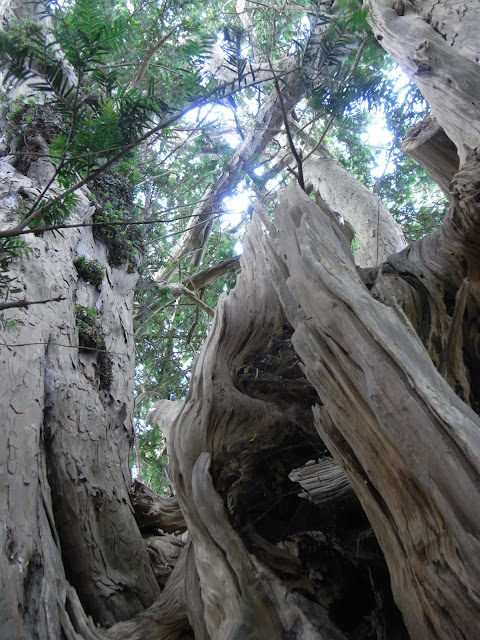 |
| The 2,000 year old Grandmother Yew, Sy Nicholas, Newington, Kent, 4th June 2017 |
“Like blue whales to land...”
On Midsummer's Day I went along to the 'Festival of the Yew Tree' organised by the Friends of St Nicholas Church, Newington. I was already familiar with the church, as I have been there to services and also to visit their 2,000 year old Grandmother Yew, but it was lovely to spend a whole day there drinking tea and listening to lectures.
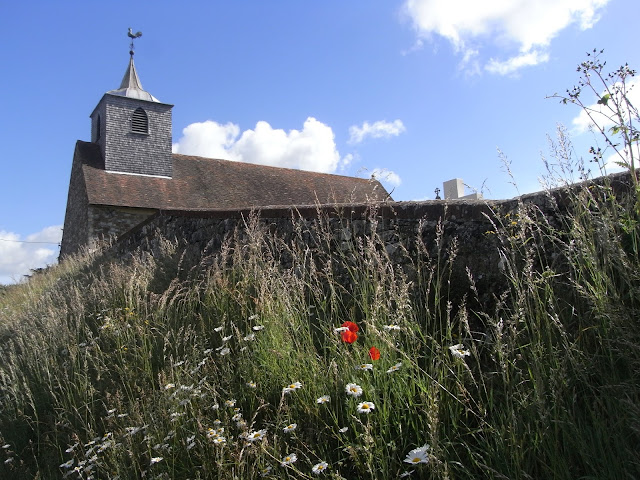 |
| St Nicholas Church, Newington, Kent, 4th June 2017 |
The church itself was built in the 12th Century and sits at the edge of the village, seemingly surrounded by jackdaw nests. They seem to be affronted by all human activity and so create a constant and marvellous hullabaloo, which I very much enjoy. Earlier in the summer the bank below the church wall was covered in oxeye daisies and poppies and the churchyard was home to the most delicate pink wild roses, so there is much to love.
 |
| St Nicholas, Newington and her wild roses, 4th June 2017 |
I have now discovered that the church has one of the last surviving underfloor medieval heating systems, much like the Roman hypocausts. Sadly it is no longer in use, which is no doubt why many of us were wearing our coats inside earlier in the spring! They have two yew trees in the churchyard; one quite young (for a yew anyway) and one ancient. She was what drew me there in the first place and I have visited her several times, finding her to be a wonderful anchoring presence in this landscape that is so dominated by the sea and its tides. Indeed, the flow of her bark often reminds me of its ebb and flow.
 |
| She flows like the sea, Grandmother Yew, 4th June 2017 |
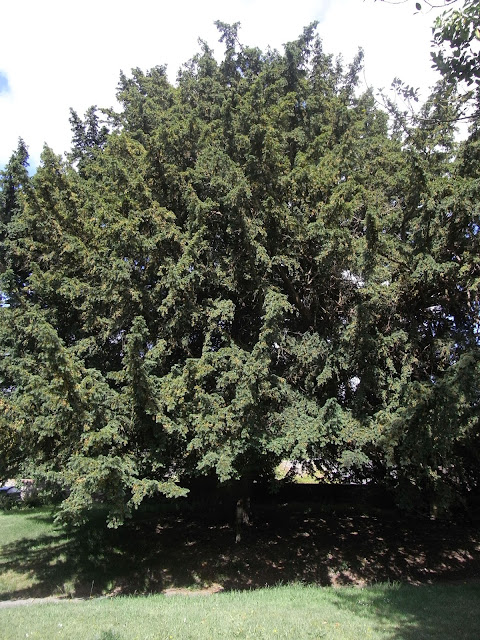 |
| The Grandmother Yew, St Nicholas Church, Newington, Kent, 4th June 2017 |
And so I found myself at the Festival of the Yew Tree, looking forward to a whole day of yew related talks and activities. The church was beautifully decorated for the event, with ivy draping the walls and looking stunning next to the stained glass windows, and we were very well looked after all through the day with frequent breaks for tea and biscuits, together with a rather fine buffet lunch.
 |
| St Nicholas Church was beautifully decorated with evergreens for the Yew Conference |
The Sauniere Society was also there with a range of esoteric books for sale. I treated myself to Jeremy Harte's, 'English Holy Wells; a sourcebook', which I am very much looking forward to reading. And indeed, Jeremy Harte was the first speaker on, 'The Mystery of the Ancient Yew'.
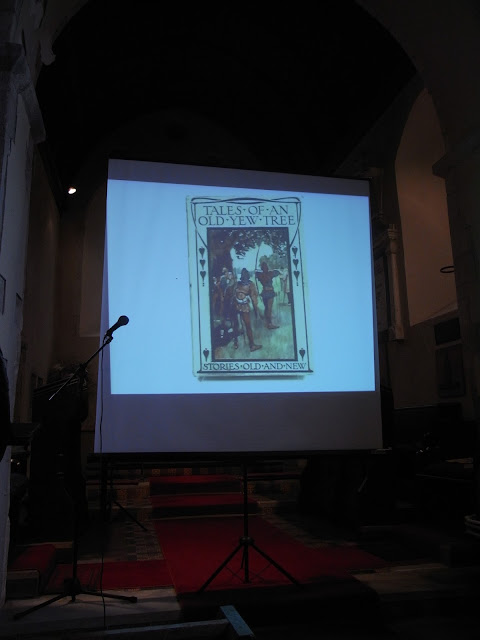
Jeremy Harte, who I have heard speak before at events in London, is an expert and researcher into folklore and has written several books, including 'The Green Man' and 'Explore Fairy Traditions'. When I first caught sight of him at this event he was attempting to manoeuvre a solid oak lectern carved into the shape of an eagle and looked very much as though he was wrestling a crocodile! However, all was eventually well and he went on to give an interesting talk, mainly about the controversial and contentious subject of accurately ageing yew trees. He began by telling us about the giant Fortingall Yew in Perthshire, which has a 56ft girth and may be Britain's oldest tree, having been aged at between 2,000 and 4,000 years old. Some have even suggested an age of 9,000 years, which seems to be one of the most mysterious things about yews; no one can accurately work out how old they are! There is much complex evidence, complicated by strategies that help yews 'live forever', but how long an individual tree may have been living is anyone's guess. It has been found that they grow quite quickly when young and then may or may not continue growing at the same rate. For example, two trees planted at the same time can vary from between 4 ft and 10 ft in girth. It is therefore impossible to measure a tree and extrapolate back in order to work out its age. Alan Meredith of the Ancient Yew Group has visited every large yew tree in England and has pushed back many dates but often his ideas seem not to fit in with the available historical information. Even then we were told that there is much 'pseudo history' relating to yew trees and so most things should be approached with a pinch of salt. Some grow in datable landscapes, such as deer parks which were often laid out and enclosed as land once held in common was claimed for the few from the 1500s onwards, and there was an early medieval tradition of planting yews but for all this their age is often impossible to guess. They are 'one unto themselves'. I love that the more we feel that we know about yews the more mysterious they seem to become!
We heard that Ireland was once an important centre for yew trees, and that evidence of this can be found in both the extensive indigenous literature and in writings by visitors, such as Giraldus Cambrensis (Gerald of Wales) who travelled there in the 12th Century. When Saint Patrick converted Ireland to Christianity in the 5th Century he found a land which already had its own well developed laws and teachings, which the inhabitants refused to abandon. However, both cosmologies included sacred trees. The yew became associated with the 'saint as ancestor' and both St Patrick and St Columba, who founded the important abbey on Iona in Scotland, are depicted with yew trees.
The Yew of Ross, which grew in Leinster and was said to be the 'offspring of the tree that is in Paradise', was a particularly significant tree in Ireland. This significance shines through in the 'Praise Song of the Tree of Ross', which describes it as, 'a King's Wheel, a Prince's Right, a Wave's Noise, Best of Creatures, a Straight Firm Tree, a Firm Strong God, Door of Heaven..a Fruitful Sea, Beauties Honour, Shout of the World, Banba's Renown, Noblest of Trees, Dearest of Bushes, a Bear's Defence, Vigour of Life, Spell of Knowledge, Tree of Ross.' However, sadly the depth of meaning held in this holy tree was not respected by early Christianity. The 'Life of St. Laserian' says that, because they wanted its wood, a group of clergy, not daring to cut the tree down outright, 'took turns at fasting and praying' around the tree until it fell. Further attacks on the yews of Ireland occurred when the English invaded in the 16th Century and began to confiscate and colonise land. Many of these ancient trees were cut down to make way for 'plantations'; for the 'planting' of settlers, more than trees. The yew tree had been thought of as the 'abiding centre' in Ireland and was a sacred tree associated with the honour of the community so, sadly, it makes sense that invaders, both Christian and colonial, would want to subdue the people by desecrating their holy trees. We might imagine that similar things happened in England and yet we are blessed that so many of our yew trees remain.
 |
| Her ancient heart, The Grandmother Yew, St Nicholas Church, Newington, 4th June 2017 |
The second talk, 'Medicines of Yew Old and New', was by retired pharmacist, John Linch-Batten, who told us that yew has been documented as a treatment for arthritis and bladder problems and has also been used as a sedative in India. He went on to explain the origins of modern medicine, beginning with the schools of medicine in the Middle East in the 12th and 13th Centuries up until the foundation of the NHS here in the UK in 1948 which made healthcare accessible to all. He bemoaned the fact that much modern medicine seems to treat the symptom, rather than the disease itself, and talked a little about the different approach found in Chinese medicine and others. He told us that he feels all forms of medicine have their place and that it is a loss to us all that they are often in tension, rather than working together. He said that when he began his training in the early 1960s pharmacists were still making their own compounds, mainly from vegetable extracts, and that he considers this to be an art form. He said that chemists have now taken over from herbalists and so extract the active compounds, rather than using the whole plant. There is now a "swing back to the natural", with the healing powers of many plants being investigated. Returning to the yew, he told us that the potential of the Pacific yew to attack cancer cells was examined in the 60s but that it was found that the bark of six 100 year old trees would be needed to treat one patient. However, studies of the English yew have made it possible to create the anti-cancer drugs, 'taxals', which came into production in 2001. These are made using only new growth, rather than old wood, and so their availability is affected by the growing season; in dry years there will be less growth and so taxals will be less readily available. He said that clippings are collected from 4,000 UK gardens by a very small number of companies, that 1 ton of yew is needed to make 1lb of compound, and that the molecules needed to make the drug begin to destabilise 8 hours after harvesting. All this means that the price of the drug is extremely variable, with the current price of raw taxal being $17,000 per ounce! Hearing all of this I was even more in awe of all that the NHS does to care for us.
 |
| Her medicine, the Grandmother Yew, St Nicholas, Newington, 4th Nune 2017 |
After a delicious buffet lunch (yum!), tree surgeon, arboriculturalist, and member of the Ancient Yew Group, Russell Ball spoke on 'Old Yew Trees and Best Practice for their Management'. He explained to us that the terms 'ancient' and 'veteran' yew have very specific meanings, signifying that these yews are 800+ or 500+ years old respectively. He described yew trees as a 'travel lodge' for biodiversity, with their hollows, cavities, holes, and deadwood. Alarmingly, ancient yews, both in Europe and globally, are a threatened genera. He talked of great stands of yew trees being felled on a huge scale to make English longbows from the 13th to the 16th Centuries, of the rush for taxane alkaloids for use in medicine in the 60s, and of yew trees being removed as a 'toxic threat' to horses and cattle. Nevertheless, the most significant and vital refuge for yew trees is now English, Welsh, and Scottish churchyards, with 84% of our 270 ancient yews being found on church land. This refuge is so important that Fred Hageneder, in his 'The Ancient Yew: a History', describes Britain as a 'Noah's Ark' for ancient yews; something to be proud of but also concerned by. It is such a responsibility to care well for these ancient grandmothers and grandfathers!
 |
| She is the first door, the Grandmother Yew, St Nicholas Church, Newington, 4th June 2017 |
Russell went on to tell us that many yews are surprisingly under threat even in churchyards due to development works ~ root loss due to expanded car parks or toilet blocks, for example , misguided tree management ~ 'lopping and topping' ~ spurious building subsidence insurance claims, and risk averse management. He said that good stewardship is the key in all these circumstances and that yews are “1,000 years in the growing and an afternoon in the killing”! A sobering thought indeed. Because yews, and other trees, can be so easily harmed ~ which might not be obvious immediately as they can take several years to die ~ Russell suggested that they should be made subject to a conservation order, which would protect them from many of the hazards he mentioned, but also from a change of church management to less yew-friendly humans.
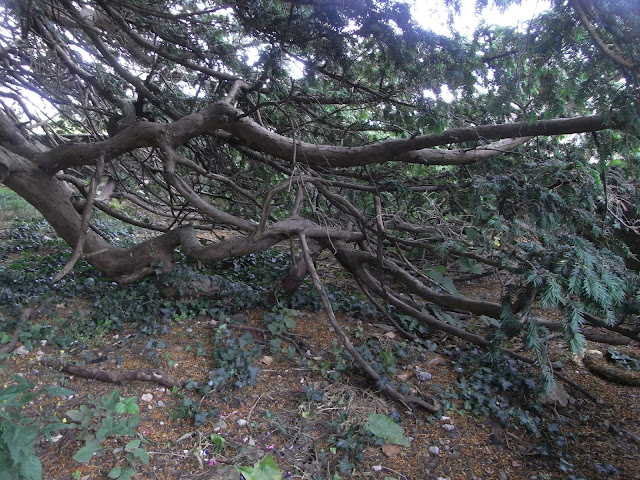 |
| Yew trees, which have shallow roots, stabilise themselves by putting sweeping their branches down to the ground |
We also learned that yews stabilise themselves by putting down branches that sweep down to the ground. These branches are able to root, slowly growing a new tree, and so there is a sense in which our ancient yews are slowly 'walking' across the land. I felt more and more as the day went on that yews are more animal than tree, or should have their own category like fungi! Returning to how yews remain standing, they also have aerial roots, which grow down through the hollow centres of older trees where much lovely rotted material will have gathered. This is known as 'retrenchment'. I know that I would like to develop that ability; to constantly 're-root' and re-establish connection with the ground of my being.
 |
| Clearly showing aerial roots growing down through her hollow heart |
After opening our eyes to the wondrous ways of the yew, Russell led us out into the churchyard where he gave advice about how best to care for the two yews there. I know that the people who help to manage them listened with great interest and I'm sure that the yews will benefit from his wisdom.
 |
| Tree expert, Russell Ball gives a workshop on how to care for our churchyard yews |
The final talk was 'The Natural History of Old Yew Trees' by ecologist and mycologist, Martin Newcombe who was an engaging speaker and further enchanted us with the magic that surrounds yew trees. He told us that yews are part of a family of fairly primitive conifers, which also includes spruce, larch, and cypress. I was fascinated to hear that there are many species of yew; European, Himalayan, Chinese, Japanese, Sumatran, Florida, Mexican, and Western (N. American)! These can look very different from our own native yew, some almost like grasses, but all are long-lived.
There are a huge concentration of yews in England, especially in the south but beginning to fade in number as we go west and north. Martin showed us a map which claims to record all English yews, but which has missed some, including a small and 'secret' yew of at least 200 years of age snuggled in a holly wood, which has existed since at least the 8th Century in Dungeness, Kent. I love that even on our own small island there are so many secrets to uncover and so many possible moments of quiet intimacy with hidden nature.
We learned that yews are 'dioecious', which means that individual trees are either male or female. However, the Buckland yew in Dover changed sex when it was moved! Again, no one truly understands why this might happen. The tree has now settled back into its former female self but still retains one or two male branches. I looked this up after the event and learned that the male trees produce wonderful golden clouds of pollen in the spring (I love to give the branches a gentle shake) and that the females birth the berries, more properly 'arils' (berries enclose the seed and arils expose them), in the summer and autumn. The seeds are highly toxic, as are most parts of the yew, and so should not be eaten, although I do know of brave souls who have made 'yewberry jam' by carefully removing the black seeds from the red flesh. Speaking of pollen, yew trees are usually 'anemophilous', which means that they are wind pollinated. Bees and other pollinators will collect pollen but don't visit yews everywhere that they grow. Another mystery, as no one understands why this should be. Bees and yew trees have a private relationship that we know little of, and I am quietly pleased.
 |
| Male yew flowers, St Mary's Church, Plaistow, 16th March 2016 |
 |
| Female yew 'cones', St Nicholas Church, Newington, 4th June 2017 |
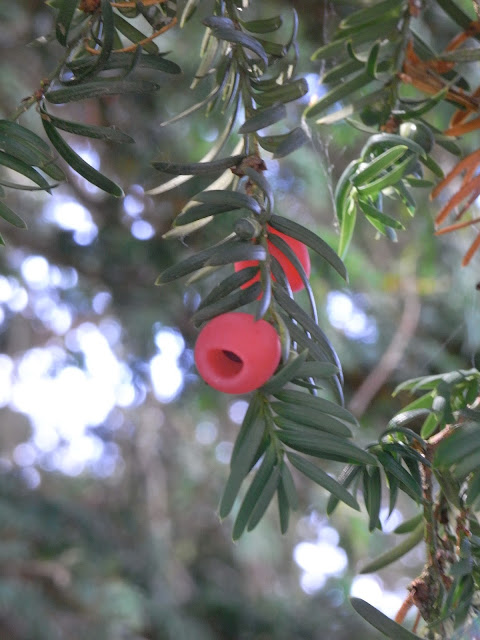 |
| Female yew arils, the Grandmother Yew, Newington, 7th July 2017 |
Martin also told us of other beings that yew is in deep relationship with. He described yew as the 'Buddha of the plant world', colonising slowly and needing protection in her early years. Seedlings often grow with juniper, which protects their tender beginnings and allows then to grow up and through. Indeed, there are two types of 'plant community' for yew trees; whitebeam~yew woodland and dog's mercury~ yew woodland. The first type includes whitebeam, together with elderberry, the occasional ash, oak, and beech, some box, often with bare ground beneath. Dog's mercury~yew woodland is comprised of ash, whitebeam, elderberry, spindle, and clematis. It is still not understood why yew and whitebeam have such a close relationship. Yew woodland is now rare, although there is evidence that the scarp face of the North Downs was once covered in yew woods. Remaining examples, 90% of which are on chalk, are to be found at Kingley Vale, near Chichester in West Sussex, the Medway Gap, and the Lake District (very recently declared a World Heritage Site!). All are SSSIs and extremely precious.
 |
| Kingley Vale yew, 16th April 2014 |
 |
| Kingley Vale yew, 16th April 2014 |
Yew has a huge root system and is excellent at collecting rain water, also putting natural herbicides into the soil to keep the ground clear and reduce competition for moisture. This makes it difficult for many plants to grow with her but some do. Mostly these are plants which leaf very early in the spring, as whitebeam and dog's mercury do. Ground cover plants that do grow are often 'noxious', such as stinking iris and cuckoo pint. How deeply evocative a landscape filled with dark enchantment yew sings into being. Few invertebrates live with yew and so they provide poor environments for birds like robins. However, the beautiful mistle thrush is truly the 'yew bird', a specialising in dealing with yew arils and setting up a feeding territory amongst the yew trees, returning to its night roost to clean its beak and spread the seeds ~ yew arils are sometimes known as 'snot berries' because they are covered in a mucus that helps them stick to beaks!
 |
| Mistle thrush (juvenile), Wiki Commons, via David Friel on Flickr |
Nuthatches are able to split the seeds but it isn't clear whether they are affected by the toxins in yew seeds. We might assume that the birds which eat the seeds have evolved with the tree and so will be unaffected. Martin told us that he has eaten the arils many times (not recommended!) and survived and so he may well have evolved in the same way! Goldcrests breed in conifers and love yew trees, badgers and squirrels eat the arils. It may be that this suppresses their metabolism ~ possibly echoes here of yew being used as a sedative in ancient Indian medicine. As for fungi, beech and oak sustain 2,200 species and yew only 258, mostly simple micro fungis and slime moulds, although earth stars are common in some yew woods. Whereas willow supports 450 insects, and oak 423, yew is in intimate relationship with only 6. Every new morsel of information I learned was like a poem, making yew ever more precious by the moment.
 |
| The warmth of yew wood, Brecon Beacons, Wales, 14th March 2010 |
Finally, Martin told us with some glee about the 'artichoke gall', which can be found on yew, diverting energy from the tree, and which houses a tiny fly. He informed us that this gall has its own parasites which lay their eggs inside it and feed on the fly larva and that these parasites have their own parasites; like a tiny living Russian doll! Truly nature is ever unfolding in its surprising wonderfulness!
This was a fine day and I am very grateful to the Friends of St Nicholas Church for making it possible. I left even more enchanted with yew trees and more in awe of the Grandmother Yew in their churchyard than ever. I thought that day, as I often do, of her roots which have been growing in this land since before the Romans came, before even the birth of Christianity. Often she seems to tower above the church, as well she might. Next time I meet her I will whisper the words 'like blue whales to land' to her as a prayer. I want her to know that she is seen.
 |
| The 2,000 year old Grandmother Yew seems to tower over St Nicholas Church, Newington, 4th June 2017 |
This has been a long piece of writing, and I hope that there will be much here to cause us all to cherish our precious yews, but I haven't written much of her heart and my own experiences with yew. As a small balance to that I will end with this image of a 'yew spirit' I met on a trip to Wales in 2010. She seems to me deeply gentle and kind and yes, patient. A much needed prayer for this world of ours indeed.
 |
| 'Yew spirit', Brecon Beacons, Wales, 14th March 2010 |
References ~
Robert Bevan-Jones, The Ancient Yew: a History of Taxas baccata
Plantations of Ireland, Wikipedia
England Enclosure Records and Maps, familysearch.org






















I was wondering if I'd seen yews -- well, of course, I had, but seen them to recognize them -- & then realized I've seen the not-actually-berries! Thank you for this, so much I've learned here.
ReplyDeleteOh, I am so glad, Kate. Thank you! It can be confusing to identify trees when they have so many different manifestations. I have a lot to learn. Exciting isn't it! xx
DeleteThankyou. You and Yew are both wondrous xxx
ReplyDeleteOh, thank you Christine! Imagine being thought wondrous like a yew. You have made my day! xxx
DeleteA wonderful article, beautifully written with love and wisdom. Thank you for sharing it with us.
ReplyDeleteThank you so much, Freyalyn. I am so pleased that it feels that way. I know that I have much to learn about yew trees but this was a fine start! x
DeleteI had been doing some research on the Yew as I was hoping to plant a yew hedge in my garden, when I came across your article. I really enjoyed reading it. You have written this beautifully and with great detail. Thank you.
ReplyDelete